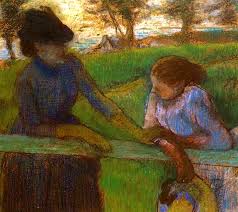Mindfulness of Conversation

Mindfulness of Conversation: The Dance of Speaking and Listening
December, 2018
Since we spend a large part of our lives talking to people, engaging in conversation can itself be a dynamic and fully engaged mindfulness practice. Just as we can explore the internal world of the body and thoughts in sitting practice, we can explore the external world of language in vocalized words, gestures and spoken interaction. This focus of attention helps open the senses, heart, and mind to receive the present moment more fully.
Mindfulness of conversation begins with the embodied experience of speaking and listening. However, far more than simply denuded ‘present moments’ of mindful awareness, there are many other layers of the experience of conversation that reflect what is happening in the ‘relational moment’. Some of the layers have to do with what is being conveyed— communication— and others with the how— the connection between us conversation. In the framework of Buddhist meditation practice, all of this falls under the heading of relational mindfulness.
The experience of conversation provides a window into the relational moment, a stage for observing the theater of the mind. Mindfulness of conversation allows us an up-close and personal experience of basic psychological phenomena and relationship patterns enacted in real time. We can observe how we show up in the relational world and we can discover a great deal about who we take ourselves to be. We can investigate what we enact with others (and what they enact with us); we can inquire into the psychological sources of those relational patterns; and we can reflect on the narratives we use to frame our experience. In all of these ways, we can gain understanding of our relational dynamics: our interpersonal reactions and their emotional roots*.
Each of these dimensions provides a variety of opportunities to observe how we relate to others in the dance of conversation. We can observe what happens at the intersubjective intersection: the intimacy or distance we experience moment by moment; our comfort or discomfort; whether we lead or follow; the energy, tempo, and flow of what we say.
In addition to the interpersonal domain, we can mindfully observe the conversation that takes place within our minds. Inner speech may manifest in words or phrases that catch our attention; at other times, it can be elaborated into ideas we want to express. We may notice replays of actual conversations we have had with others. Our minds may host soliloquies or arguments, or fantasize entire interactions. These narrative themes shed a lot of light on our actual interactions with others.
To summarize, there are at least three interwoven strands in mindfulness of conversation: communication with others, our inner narratives, and the felt sense of our symbolized experience. Through mindfulness of conversation we can discover many different voices, many different layers of knowing and cognizing within. There is value in becoming aware of the entire process.
Most importantly, mindful attention to the process of communication entails potential for change in both participants. This is especially true because communication reflects the underlying stories we tell ourselves (consciously or unconsciously) about self and other. It provides an opportunity to observe both our biases and our intentions. And, it creates an opening to practice the Buddhist principles of wise speech.
One of the most exciting aspects of the dance of speaking and listening is the realization that communication is a generative act; no one knows in advance what will transpire. It is as much (or more) an event that happens to us as it is something we ‘do’. Conversation invites something to “emerge” between ourselves and another. This potential is what the writer Ursula Le Guin “the calls beauty and terror of conversation, that ancient and abiding human gift.”
A longer version of this essay appears in Wise Brain Bulletin, vol. 12.5: “Speaking and Listening: The Intimate Dance of Communication”. http://www.wisebrain.org/tools/wise-brain-bulletin/volume-12-5.
REFERENCES
** Schuman, M. (2018) Mindfulness-Informed Relational Psychotherapy and Psychoanalysis: INQUIRING DEEPLY
Picture credit Edgar Degas, The Conversation.
